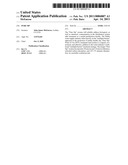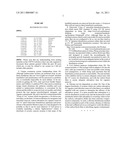Patent application title: Pure Sip
Inventors:
John James Mcencroe (Golden, CO, US)
IPC8 Class: AC02F134FI
USPC Class:
210 86
Class name: Liquid purification or separation with alarm, indicator, register, recorder, signal or inspection means material level or thickness responsive
Publication date: 2011-04-14
Patent application number: 20110084007
ll reliably address biological, as well as
chemical, contamination in the distribution system after treatment at a
central purification facility. The Public water supply industry relies
heavily on the "multiple barrier" approach in the protection of public
health; the "Pure Sip" Point of Use (POU) treatment unit/system is a
logical, economical, and effective, addition to the water industry's
traditional "multiple barrier" treatment strategy. The unique "Pure Sip"
system incorporates 10 micron and 1.0 micron filtration, activated carbon
adsorption, and 12V UV primary disinfection, in a portable countertop
unit.Claims:
1. Unique countertop system (independent claim #1): Although undercounter
systems are preferred from an aesthetic standpoint, they are "out of
sight-out of mind" and their installation and maintenance will be
perceived as problematic, or essentially impossible, by most utilities.
To be successful in getting the EPA, state and local Health Departments,
and Utilities, to embrace POU, they need a countertop design which
eliminates the nebulous variables and costs related to undercounter
installation, is convenient for the citizen and the utility to swap out
every six months, and which protects the user against microbiological,
inorganic, and organic contaminants. My unit is the first
countertop/portable "Point of Use" system which incorporates a 10 micron
particle filter, an absolute 1.0 micron filtration for inorganics and
microbial removal, carbon adsorption for organics removal, and "A" rated
Ultraviolet Disinfection (upstream and downstream of the particle
filtration steps) in a unit designed to be portable so that it can be
used wherever 12 Volt power is available (including a vehicle
"lighter/power" outlet). A drawback of reverse osmosis systems is that
many of the healthful minerals are removed from the water; a 1.0 micron
filter will not remove these beneficial constituents.
2. Ultraviolet "Class A" microbial disinfection/inactivation which meets NSF standard 55 using 12V DC power (dependent on claim #1). (http://www.nsf.orq/business/drinking water treatment/standards.asp?program=DrinkinqW atTre). Although there are two existing systems which could conceivably be used as portable units, they are not configured to be so, nor are they rated as UV "A" (primary disinfection systems); rather, they are rated as UV "B" (secondary disinfection systems). The units are Puritec and Hydrotech: http://www.puritec.com/store/moreinfo.cfm?Product ID=228, http://www.hydrotechwater.com/UV%20Sterilizers/pura uv b.htm. Please note that a bacteriostat, incorporated within a carbon block type filter, and designed to control the non-pathogenic heterotrophic growth frequently encountered in such a filter, would not serve as an adequate barrier in the event of a serious bacteriological contamination event within the distribution system.
3. Civil Defense purposes (independent claim #2): The system includes a 1 liter syringe with an adapter to fit onto the unit's sink tap connection to treat non potable water during civil emergencies, or while being used anywhere that the distribution system pressure is unavailable. The unit includes a flow inhibitor device to ensure adequate contact time with the UV source for disinfection, and with the carbon block filter to ensure adequate adsorption time for organics removal.
4. Chlorine test kit (dependent on claim #1): One of the biggest drawbacks of systems which use carbon adsorption for organics (and chlorine) removal is that there is no method supplied with any system to determine the efficacy of the adsorption system. It is quite possible that subsequent to a serious distribution system event, that the homeowner would mistakenly believe that adsorption is occurring, when in fact the carbon's adsorption ability has been seriously compromised or exhausted. As such, a chlorine disinfectant residual test kit is included as part of the system; absence of chlorine in the unit's effluent serves as a surrogate to verify the efficacy of the carbon block filter at adsorbing organic contaminants.Description:
REFERENCES CITED
TABLE-US-00001 [0001] 7,404,894 Jul. 29, 2008 Yamaguchi 7,090,779 Oct. 20, 2004 Berstein 6,478,956 Nov. 12, 2002 Kaura 6,402,949 Jun. 11, 2002 Banks 6,379,544 Apr. 30, 2002 Chen 6,344,146 Feb. 5, 2002 Moorehead 6,024,867 Feb. 15, 2000 Parise 5,656,160 Aug. 12, 1997 Parise 5,433,848 Jul. 18, 1995 Platter 4,902,411 Feb. 20, 1990 Lin 4,556,484 Dec. 3, 1985 Hunter
[0002] Please note that my understanding from reading material on the USPTO website is that I am only required to document those patents granted within the past 20 years which are, or may be, related to my system (so I did not include older patents).
Claims:
1. Unique countertop system (independent claim #1): Although undercounter
systems are preferred from an aesthetic standpoint, they are "out of
sight-out of mind" and their installation and maintenance will be
perceived as problematic, or essentially impossible, by most utilities.
To be successful in getting the EPA, state and local Health Departments,
and Utilities, to embrace POU, they need a countertop design which
eliminates the nebulous variables and costs related to undercounter
installation, is convenient for the citizen and the utility to swap out
every six months, and which protects the user against microbiological,
inorganic, and organic contaminants. My unit is the first
countertop/portable "Point of Use" system which incorporates a 10 micron
particle filter, an absolute 1.0 micron filtration for inorganics and
microbial removal, carbon adsorption for organics removal, and "A" rated
Ultraviolet Disinfection (upstream and downstream of the particle
filtration steps) in a unit designed to be portable so that it can be
used wherever 12 Volt power is available (including a vehicle
"lighter/power" outlet). A drawback of reverse osmosis systems is that
many of the healthful minerals are removed from the water; a 1.0 micron
filter will not remove these beneficial constituents.
2. Ultraviolet "Class A" microbial disinfection/inactivation which meets NSF standard 55 using 12V DC power (dependent on claim #1). (http://www.nsf.orq/business/drinking water treatment/standards.asp?program=DrinkinqW atTre). Although there are two existing systems which could conceivably be used as portable units, they are not configured to be so, nor are they rated as UV "A" (primary disinfection systems); rather, they are rated as UV "B" (secondary disinfection systems). The units are Puritec and Hydrotech: http://www.puritec.com/store/moreinfo.cfm?Product ID=228, http://www.hydrotechwater.com/UV%20Sterilizers/pura uv b.htm. Please note that a bacteriostat, incorporated within a carbon block type filter, and designed to control the non-pathogenic heterotrophic growth frequently encountered in such a filter, would not serve as an adequate barrier in the event of a serious bacteriological contamination event within the distribution system.
3. Civil Defense purposes (independent claim #2): The system includes a 1 liter syringe with an adapter to fit onto the unit's sink tap connection to treat non potable water during civil emergencies, or while being used anywhere that the distribution system pressure is unavailable. The unit includes a flow inhibitor device to ensure adequate contact time with the UV source for disinfection, and with the carbon block filter to ensure adequate adsorption time for organics removal.
4. Chlorine test kit (dependent on claim #1): One of the biggest drawbacks of systems which use carbon adsorption for organics (and chlorine) removal is that there is no method supplied with any system to determine the efficacy of the adsorption system. It is quite possible that subsequent to a serious distribution system event, that the homeowner would mistakenly believe that adsorption is occurring, when in fact the carbon's adsorption ability has been seriously compromised or exhausted. As such, a chlorine disinfectant residual test kit is included as part of the system; absence of chlorine in the unit's effluent serves as a surrogate to verify the efficacy of the carbon block filter at adsorbing organic contaminants.
Description:
REFERENCES CITED
TABLE-US-00001 [0001] 7,404,894 Jul. 29, 2008 Yamaguchi 7,090,779 Oct. 20, 2004 Berstein 6,478,956 Nov. 12, 2002 Kaura 6,402,949 Jun. 11, 2002 Banks 6,379,544 Apr. 30, 2002 Chen 6,344,146 Feb. 5, 2002 Moorehead 6,024,867 Feb. 15, 2000 Parise 5,656,160 Aug. 12, 1997 Parise 5,433,848 Jul. 18, 1995 Platter 4,902,411 Feb. 20, 1990 Lin 4,556,484 Dec. 3, 1985 Hunter
[0002] Please note that my understanding from reading material on the USPTO website is that I am only required to document those patents granted within the past 20 years which are, or may be, related to my system (so I did not include older patents).
User Contributions:
Comment about this patent or add new information about this topic:


